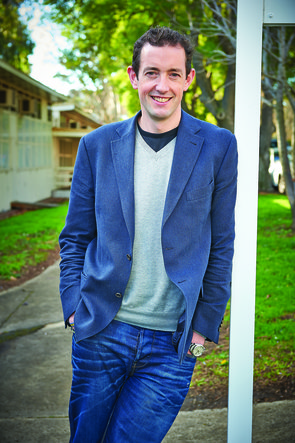Australian Professor talks IPS
WHEN I first received an email from University of Melbourne Director of Psychosocial Research Professor Eoin Killackey (pictured below), I noticed his signature ended with the words, "Opening minds to a brighter future."
After speaking to him about Individual Placement & Support for nearly half an hour, I could tell this was one motivated man who, through his research, was helping many people not only open their minds, but free them too.
Compared to efforts abroad, there is relatively little data supported by Australian research into IPS. That’s why Killackey and his local trial sites have breathed fresh air into the local IPS campaign.
“There’s plenty of evidence from the government which shows people with mental illness, particularly more severe mental illness, might be the largest disability group accessing Disabil ity Employment Services, but they’re the group who do the least well out of those services,” Killackey said. “It’s really imperative to think of a different way of addressing that problem.”
ity Employment Services, but they’re the group who do the least well out of those services,” Killackey said. “It’s really imperative to think of a different way of addressing that problem.”
Almost a decade ago, Killackey and his research team at the Orygen Youth Health Research Centre decided to look at vocational outcomes of people presenting with first episode psychosis and looking at different possibilities to help them.
“We decided we would trial the IPS approach,” Killackey said.
They hired a person from the employment sector outside of mental health and conducted randomised controlled trials.
“We did that trial and 85% of people who worked with her went back to work or school,” Killackey said. “In the controlled condition, where people could go to the regular job services, only 29% of those people got school or work outcomes.”
So if IPS produces such great outcomes, why is the model not more widespread?
One of the major barriers for IPS transitioning from being a research intervention to being a normal part of the interventions offered is finding the money to support the IPS worker position.
“Because the health system isn’t set up in such a way that it funds people to do that, we figure why wouldn’t you just send people to the employment system to get a job,” Killackey said. “We had a very long process of actually trying to get funding.”
In one instance, a service sacrificed a clinical position to fund an IPS position, because they realised the outcomes were so valuable to clients that it was worth doing. Another challenge some IPS specialists face is entering mental health systems, without a mental health background.
Boundaries between the health and employment sectors also exist between the jurisdictions which determine funding.
“It becomes a little bit of a tricky thing - the state government says great idea, but it’s a federal responsibility, and the federal government goes that’s a great idea but that’s for the state mental health system,” Killackey said.
Perceptions of workplace stress are also acting as a barrier to people with mental health problems from gaining work.
“Among the mental health workforce, a lot of people see work as being stressful and that it might lead to an exasperation of illness,” Killackey said. “When I was learning to be a clinician in the early 1990s, we were taught to tell people to rest, take time off, don’t worry about working at the moment, use the welfare benefits system to support yourself.
“But no consideration is actually given to the fact that being unemployed is actually really stressful as well. I think there’s still that kind of attitude that can work against IPS incubating well into the clinical teams.”
Killackey goes on to argue that mental health clinicians should be able to put strategies in place to manage any work-related stress. Comparatively, it’s difficult to quantify what the stresses around being at home and being unemployed are going to be and intervene.
To implement IPS more widely across Australia, Killackey believes there are two broad approaches needed.
“One is a partnership approach with employment agencies,” he said. “That’s probably the more likely approach that requires changes from both the Mental Health Services and the job services side, so they actually genuinely collaborate and work together. On the job service side of things, you need to have an arrangement where it makes financial sense for lower case load.
“The other option of course is that health services directly employ employment people, but it requires mental health services to have a much broader view of their role in recovery than they currently do.”
Since this article was published, Eoin Killackey has gone onto publish the first report on IPS for the Australian context, 'Tell Them They're Dreaming'. Download here.
For more on Individual Placement and Support, please go to our new website: http://ipsworks.waamh.org.au/